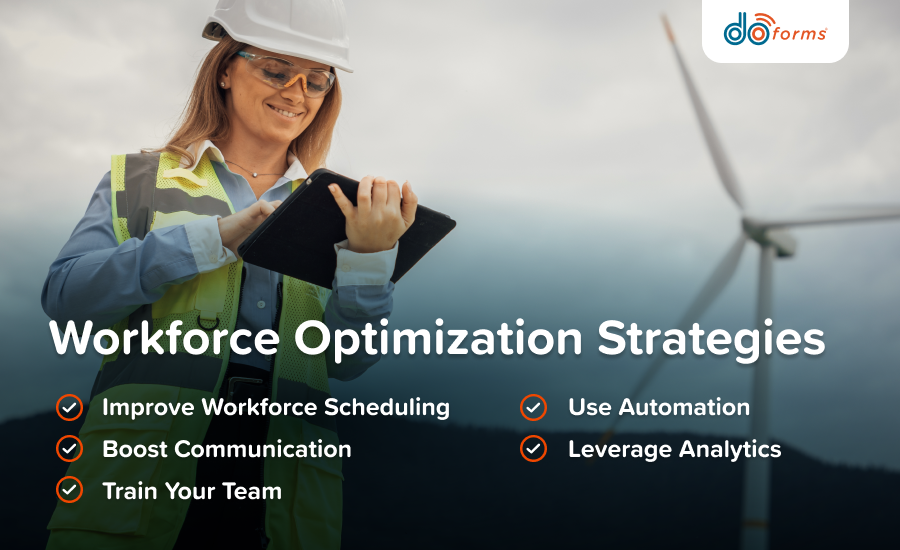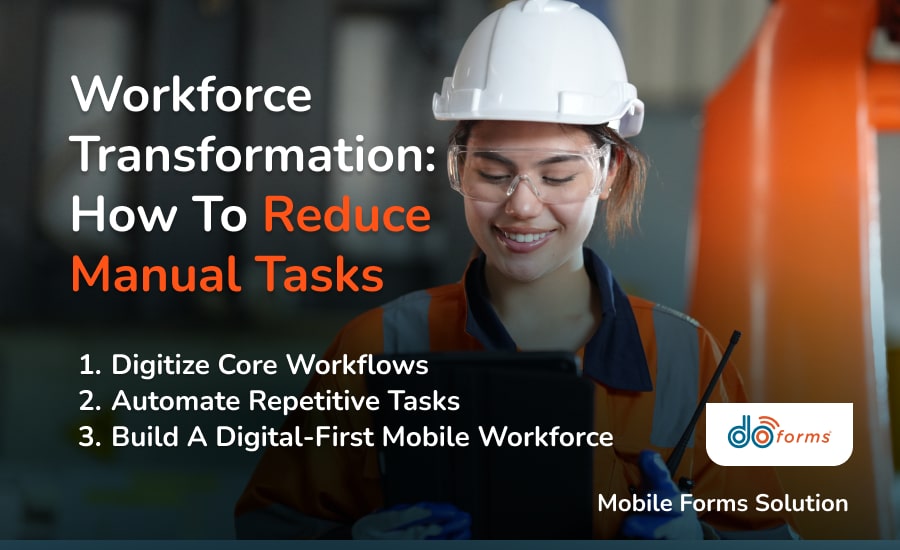
Workforce Optimization Strategies: Key Points
- To optimize your workforce, implement automated scheduling and use performance analytics
- Provide ongoing training to enhance employee skills and increase engagement
- The benefits you can expect include improved productivity, cost savings, better resource allocation and higher employee satisfaction
Are you tired of complicated staff schedules, frustrated employees and operational bottlenecks?
It can be quite difficult to manage a team, especially when you have few resources available and a lot of work to do.
In this article, we will:
- Share strategies for building a motivated and efficient team
- Explain the benefits of workforce optimization
- Answer common questions
- Present doForms, a modern workforce optimization solution that will help you grow your company
Looking to optimize your workforce?
Try doForms For Free!
Workforce Optimization Strategies
So how can you boost productivity while delivering great customer service and keeping employees happy? The following strategies will help you build a motivated team focused on providing the best results.
Improve Workforce Scheduling
Effective scheduling is key to achieving better results, enhancing customer satisfaction and supporting employee well-being.
- Use scheduling tools that analyze workload patterns, employee availability and business demand to avoid understaffing and overtime.
- Give employees the option to swap shifts or set availability preferences.
Boost Communication
Clear communication helps teams work better together, minimizes misunderstandings, strengthens teamwork and creates a positive work environment.
- Use digital communication platforms to share work schedules, updates and company announcements in real time.
- Encourage employees to provide feedback and ask questions.
Train Your Team
Ongoing employee training ensures your team can handle tasks efficiently and adapt to changing demands and environments. In addition, well-trained employees are more confident and engaged.
- Organize regular training sessions to improve technical skills, customer service and safety practices.
- Provide access to online learning platforms.
Use Automation
Automating repetitive tasks like data entry, scheduling and reporting can save time and reduce errors.
- Use automated notifications to remind employees of shifts or deadlines.
- Track employee attendance and working hours in real time.
- Use self-service portals for leave requests and approvals.
Use Workforce Analytics
Workforce analytics help improve efficiency and optimize employee allocation by collecting and analyzing data on employee performance, attendance, scheduling and productivity.
- Analyze historical data to predict staffing needs during peak times.
- Identify patterns to improve scheduling and workload distribution.

To succeed with workforce optimization, improve scheduling, boost communication and use automation
Workforce Optimization vs. Workforce Planning
Workforce optimization is closely related to workforce planning, but they are not the same thing.
What’s the difference?
While workforce planning concentrates on hiring and assigning employees to fulfill business demands, workforce optimization makes sure the team is employed efficiently to enhance productivity.
What Businesses Use Workforce Optimization
Many businesses use workforce optimization — here are a few examples:
- Retail: To ensure that consumers are satisfied with the services they receive, stores use workforce scheduling tools that allow them to add more staff at busy times.
- Healthcare: To ensure fair distribution of work, hospitals use workforce analytics that help them strike a balance between staff availability and patient care.
- Call centers: To improve response times and customer satisfaction, call centers use real-time data, planning the ideal number of personnel per shift.
- Manufacturing: To maximize production lines and minimize machine downtime, factories employ robotics, IoT-sensors and AI maintenance scheduling.

Workforce optimization finds place in various sectors, from manufacturing to healthcare and retail
Benefits Of Workforce Optimization
From improved productivity to better customer experience and higher employee engagement, workforce optimization can bring a number of benefits to your organization.
Improved Productivity
Workforce optimization streamlines workflows and creates work schedules that improve resource allocation and prioritize essential tasks.
Better Customer Experience
When you have sufficient well-trained staff providing fast service, accurate information and proactive support, your customers are happy and likely to return.
Higher Employee Engagement
When work is distributed fairly and employees have a good work-life balance, they feel satisfied with the job and are less likely to leave, reducing turnover.
Cost Savings
Smart labor allocation reduces overtime, minimizes idle time and maximizes resource use, cutting overall costs for your business.
Workforce Optimization Strategies: Key Takeaways
Workforce optimization is a complex process where you need to factor in various important points. Here’s what to remember:
- Assess your current team structure and identify weak spots.
- Use workforce scheduling tools to ensure optimal staff allocation and reduce unnecessary labor costs.
- Implement automation to streamline repetitive tasks, redirecting employees to higher-value work.
- Leverage workforce optimization solutions to digitize processes, create workforce templates and improve real-time collaboration.
Considering how to optimize your resources?
Try doForms For Free!
Considering Workforce Optimization? Try doForms
There are various workforce optimization tools available on the market that can help your businesses become more efficient. Some of these include employee scheduling software, time tracking systems and management platforms.
Among these solutions, mobile forms like doForms stand out as they allow you to:
- Digitize workforce management processes.
- Automate scheduling and task tracking.
- Streamline inter-team communication.
- Collect and analyze data in real time.
- Develop and customize workforce templates, including new hire, shift handover training and performance review checklists.
- Give staff members the ability to collaborate in real time by editing and sharing information while they are on the road.
- Organize and store documents in a secure centralized cloud location.
- Create automated reports to monitor performance and pinpoint areas for improvement.
- Integrate workforce with other systems you use to improve your workflows.
Need workforce optimization tools?
Try doForms For Free!
Workforce Optimization Strategies: FAQs
If you are still unsure about how to optimize your team’s work, check out answers to common questions asked by our clients.
Can small businesses benefit from workforce optimization?
Yes, no matter the size of your business, workforce optimization strategies will help you streamline your operations, automate tasks and enhance team productivity.
How does automation support workforce optimization?
Automation handles repetitive tasks, such as scheduling and data entry, reducing manual work, minimizing errors and improving efficiency.
Is workforce optimization expensive to implement?
While some workforce optimization solutions may require an initial investment, the long-term benefits — such as increased productivity, reduced labor costs and improved employee satisfaction — often outweigh the costs. doForms is an affordable workforce optimization option, which offers different pricing models for businesses of all sizes.
How can I measure the success of workforce optimization?
To measure the success of workforce optimization:
- Set key performance indicators (KPIs) such as employee productivity, customer satisfaction, labor costs and turnover rates.
- Regularly analyze these metrics and adjust your optimization strategies accordingly.
Can workforce optimization improve employee retention?
Yes, workforce optimization ensures fair workload distribution, career development opportunities and a supportive work environment, which makes employees feel valued and reduces turnover rates.
What’s the difference between workforce optimization and workforce management?
Workforce management handles the administration of employees, including hiring, payroll and attendance tracking. Workforce optimization uses data-driven insights and automation to fine-tune scheduling, efficiency and productivity.
How fast can I see results from workforce optimization?
The timeline to see results depends on various factors such as the implementation process, company size and optimization strategies you used. Some businesses see immediate improvements in scheduling and efficiency, while others may need a few months to integrate automation and analytics for long-term benefits.
Are you ready to make your business more efficient?
Book A Demo




